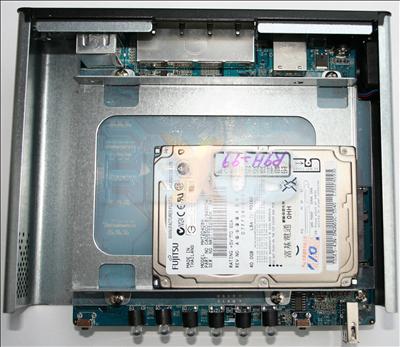A look inside
Opening the unit up is a simple case of removing the holding screws on either side and pulling the metal cover away.The front-mounted LEDs, switches, and USB2.0 port can be seen here.
Given the N1200's diminutive size for a NAS box, we also like the fact that both the standard 3.5in and smaller, laptop-orientated 2.5in SATA hard drives can be used; the choice is yours. Seagate's excellent 7200.10 750GB model would be great for super storage and, say, a 160GB 2.5in drive for extra portability.
Gaining access to the mini-PCI slot is a simple matter of removing the four screws that hold the drive cage to the chassis. The motherboard is secured by the same screws, so it pops right out.
A single fan, which you saw on the previous page, is the sole active cooling and the unit is generally quiet in operation.
The N1200 is powered by a Freescale 8347 processor and has 128MiB of onboard memory that's provided by Samsung. Other Thecus SKUs utilise separate memory modules but the lack of space available on the N1200 dictates that it's embedded, much like you'd see on any discrete graphics card.
Just to the left of the mini-PCI slot is Silicon Image's Sil3512 ASIC, a 2-port eSATA controller. Thecus uses one of the available ports on the back.
Realtek's RTL8211B transceiver runs the Gigabit Ethernet connection and Marvell's 88E6060 ASIC is used to provide the 4-port 100MBit switch (although it can handle up to 6 ports).
Lastly, the large-ish ASIC at the bottom is Intel's StrataFlash. The name gives its function away.
Hardware-wise, then, the Thecus N1200 NAS box provides an inbuilt 4-port switch, single-bay storage for either 2.5in or 3.5in SATA hard drives, eSATA, USB2.0 and mini-PCI support, all in a small enough package to put into a laptop bag. General build quality is excellent or as Mr. Borat would say 'Is Nice'












